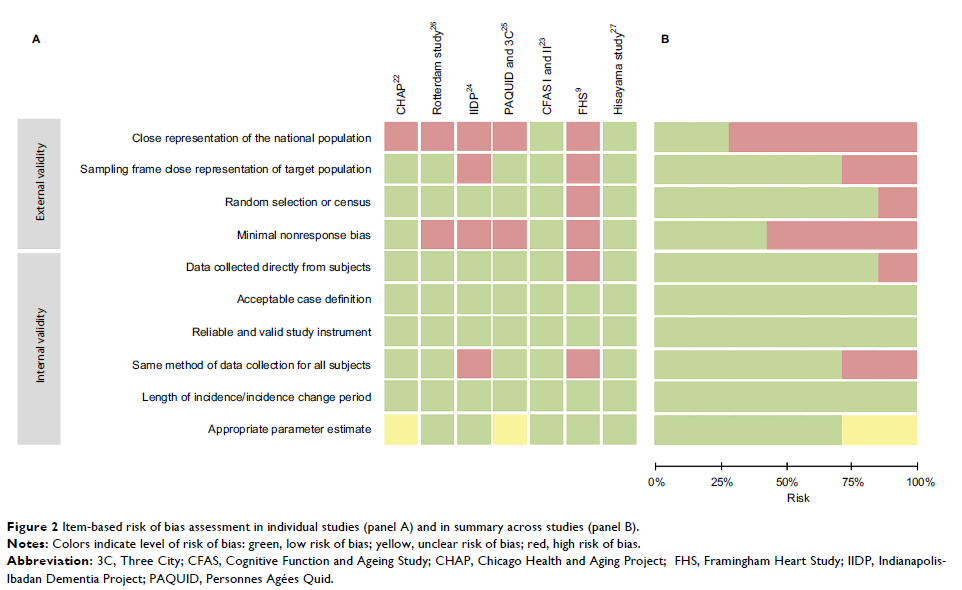108605
论文已发表
注册即可获取德孚的最新动态
IF 收录期刊
- 3.4 Breast Cancer (Dove Med Press)
- 3.2 Clin Epidemiol
- 2.6 Cancer Manag Res
- 2.9 Infect Drug Resist
- 3.7 Clin Interv Aging
- 5.1 Drug Des Dev Ther
- 3.1 Int J Chronic Obstr
- 6.6 Int J Nanomed
- 2.6 Int J Women's Health
- 2.9 Neuropsych Dis Treat
- 2.8 OncoTargets Ther
- 2.0 Patient Prefer Adher
- 2.2 Ther Clin Risk Manag
- 2.5 J Pain Res
- 3.0 Diabet Metab Synd Ob
- 3.2 Psychol Res Behav Ma
- 3.4 Nat Sci Sleep
- 1.8 Pharmgenomics Pers Med
- 2.0 Risk Manag Healthc Policy
- 4.1 J Inflamm Res
- 2.0 Int J Gen Med
- 3.4 J Hepatocell Carcinoma
- 3.0 J Asthma Allergy
- 2.2 Clin Cosmet Investig Dermatol
- 2.4 J Multidiscip Healthc

Is dementia incidence declining in high-income countries? A systematic review and meta-analysis
Authors Roehr S, Pabst A, Luck T, Riedel-Heller SG
Received 27 January 2018
Accepted for publication 4 May 2018
Published 18 September 2018 Volume 2018:10 Pages 1233—1247
DOI https://doi.org/10.2147/CLEP.S163649
Checked for plagiarism Yes
Review by Single-blind
Peer reviewers approved by Dr Andrew Yee
Peer reviewer comments 3
Editor who approved publication: Dr Henrik Toft Sørensen
Purpose: To perform a systematic review and quantitative synthesis of
studies on recent trends in dementia incidence in high-income countries (HIC),
considering study quality.
Methods: PubMed and Web of Science were searched for eligible studies, that
is, population-based/community-based prospective cohort studies investigating
dementia incidence with similar methods over time, published after 1990. Study
selection, data extraction, and quality assessment were performed independently
by two investigators. Random-effect meta-analysis and meta-regression were used
to estimate incidence change (IC) and to explore associations with study
attributes. PRISMA standards were followed.
Results: The systematic review included seven studies (42,485 individuals),
and the meta-analysis included five studies of sufficient quality. Relating
dementia incidence of later cohorts to earlier cohorts (reference) yielded a
nonsignificant decrease across HIC (IC =0.82; 95% CI 0.51–1.33), with high
heterogeneity (I² =94.9%, P <0.001) and without
publication bias (Egger’s t =–1.77; P =0.18). Excluding the Japanese
Hisayama study, the only study suggesting an increase, indicated borderline
evidence for a decrease across Western HIC (IC =0.69; 95% CI 0.47–1.00; I² =88.1%, P <0.001; Egger’s t =–0.34, P =0.77), again with high
heterogeneity. Meta-regression did not reveal an association of incidence rate
with calendar year or study attributes; however, analyses were low powered.
Conclusion: There is evidence of favorable trends in dementia incidence in
Western HIC (stabilizing/decreasing). Reverse trends may occur in HIC of other
regions, as exemplified by Japan. However, study number was small and
heterogeneity was high. Further cohort studies using consistent methods are
needed to draw definite conclusions. Our work may inform such future studies.
Keywords: dementia, Alzheimer’s disease, cohort study, incidence, trends,
epidemiology
